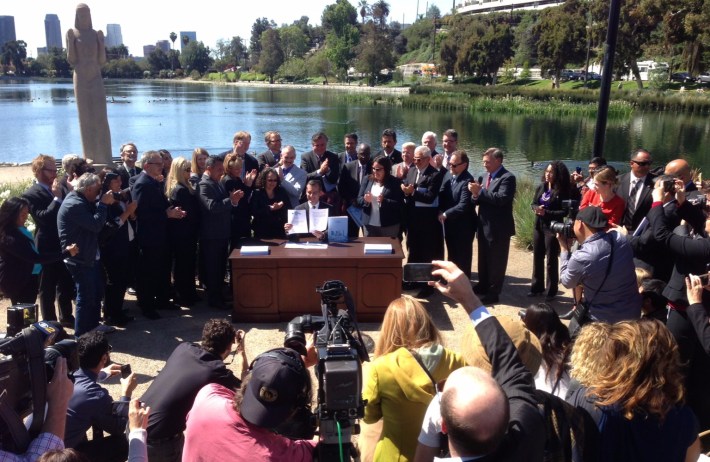
At a public signing ceremony this morning in Echo Park, Los Angeles Mayor Eric Garcetti introduced his ambitious new "Sustainable City pLAn." The environmental plan [PDF] describes itself as "a roadmap for a Los Angeles that is environmentally healthy, economically prosperous, and equitable in opportunity for all -- now and over the next 20 years." The mayor's event was well attended by more than 200 people, including city department heads and many environmental leaders.
The document is extensive, but written very simply and clearly. For each category, the plan includes very specific, measurable goals for 2025 and 2035. Additionally, it includes near-term outcomes to be completed by 2017.
There is a whole lot to like in the 100-page Sustainable City pLAn - from water to solar energy to waste to urban agriculture. This article just summarizes outcomes directly related to transportation and livability. Those include:
Mobility and Transit: (page 54)
- Outcome: Reduce daily vehicle miles traveled (VMT) by 5 percent by 2025, and by 10 percent by 2035. 2012 per capita VMT was 14.7 miles/day, according to the Southern California Association of Governments (SCAG).
- Outcome: Increase the mode share percentage of all trips made by walking, bicycling, and transit to at least 35 percent by 2025, and to at least 50 percent by 2035. 2012 walk/bike/transit mode share totaled 26 percent, per SCAG.
- Outcome: Increase trips through shared services - car share, bike share, ride share - to at least 2 percent by 2025, and to at least 5 percent by 2035. 2012 shared transportation mode share totals 0.9 percent, per SCAG.
- Near-Term Outcomes for 2017: implement 1,000-bike bike share (Metro regional bike share underway), and increase multimodal connections at 10 rail stations.
- Strategies and Priority Initiatives include: build bike infrastructure, expand and upgrade Bus Rapid Transit (BRT), expand rail network, expand dynamically priced parking, and revise parking minimums.
Livable Neighborhoods: (page 92)
- Outcome: Implement Vision Zero policy to reduce traffic fatalities.
- Outcome: Increase L.A.'s average Walk Score to 75 by 2025. Current L.A. average is 64.
- Strategies and Priority Initiatives include: Adopt Vision Zero policy, establish multi-agency Vision Zero task force, incorporate pedestrian safety into all street designs/redesigns, expand People St, and increase number/scope of CicLAvias.
Housing and Development: (page 48)
- Outcome: Increase the percentage of Transit-Oriented Development (TOD) by ensuring proportion of new housing units built within 1,500 feet of transit is at least 57 percent by 2025, and at least 65 percent by 2035. In 2014, new housing was 24 percent transit-adjacent, per L.A. City.
- Near-Term Outcomes for 2017: Issue permits for 17,000 new units of housing within 1,500 feet of transit.
- Strategies and Priority Initiatives include: Leverage re:code L.A. to promote a transit-oriented city, work with Metro on affordable housing joint development opportunities (underway), update parking regulations to foster bike and car share.
Air Quality: (page 74)
- Outcome: By 2025, zero days when air pollution reaches unhealthy levels. In 2013, there were 40 non-attainment days, per South Coast Air Quality Management District.
- Strategies and Priority Initiatives include: Convert local goods movement to zero-emission and support electric vehicle infrastructure, including greening the city's fleets.
Environmental Justice: (page 80)
- Outcome: Reduce the number of annual childhood asthma-related emergency room visits in L.A.'s most contaminated neighborhoods to less than 14 per 1000 children in 2025, and to less than 8 per 1000 children in 2035. In 2010, L.A.'s highest zip code saw 31 visits, per Plan for a Healthy L.A.
- Outcome: Ensure all low-income Angelenos live within a half mile of fresh food by 2035.
Urban Ecosystem: (page 86)
- Outcome: Complete 32 miles of Los Angeles River public access by 2025. As of 2014, 13.3 miles have public access, per L.A. City Bureau of Engineering.
Carbon and Climate Leadership: (page 34)
- Reduce greenhouse gas (GHG) emissions below 1990 baseline by 45 percent in 2025, 60 percent in 2035, and 80 percent in 2050.
And that's just the most Streetsblog-related items. There is a lots more in the ambitious visionary plan.
It is telling that the plan acknowledges the Bloomberg Associates sustainability team, including Rohit Aggarwala, the mastermind behind PlaNYC. Former NYC Mayor Bloomberg laid the groundwork for New York City's streets transformation with the quantifiable framework outlined in PlaNYC.
The plan was praised wholeheartedly by environmental and business leaders at this morning's event.
Mayor Garcetti pledged that this "is not a plan for the shelves." At today's event he signed a mayoral directive [PDF] that requires all city departments incorporate pLAn outcomes into their departmental activities. In addition, the directive establishes sustainability officers in applicable city departments and bureaus, and sets up a reporting mechanism to track city progress on pLAn outcomes.
On the issues that SBLA readers care about, the new Sustainability City pLAn is excellent. The extent to which the mayor is able to keep these outcomes at the forefront, sometimes in the face of other departmental and community priorities, remains to be seen.






